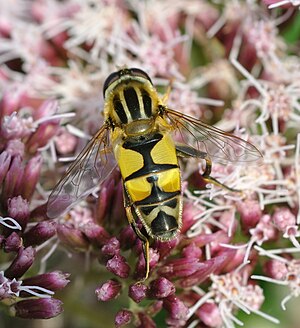Large marsh hover fly
| Large marsh hover fly | ||||||||||||
|---|---|---|---|---|---|---|---|---|---|---|---|---|

Great Marsh Hoverfly ( Helophilus trivittatus ), male |
||||||||||||
| Systematics | ||||||||||||
|
||||||||||||
| Scientific name | ||||||||||||
| Helophilus trivittatus | ||||||||||||
| ( Fabricius , 1805) |
The large marsh hover fly ( Helophilus trivittatus ) is a fly from the species-rich family of hover flies . The scientific name is made up of the parts helos (ἕλος, Greek) “swamp”, philos (φίλος, Greek) “friend”, tri (Latin) “three” and vitta (Latin) “ribbon, sash” . Helophilus refers to the fact that the insect prefers moist areas, trivittatus is explained by the fact that the fly has three stripes on the breast shield. The drawing of the abdomen is reminiscent of a wasp.
Anatomical features
With a body length of fourteen to seventeen millimeters, the great marsh hover fly is one of the largest Central European hover flies. As with the other species of the genus Helophilus , the back shield has striking black and white stripes. Four light gray to pale yellow stripes alternate with three dark brown to black stripes. As a rule, the light stripes are narrower than the dark ones.
The head is directed forward. The antennae next to each other are deflected on an elevation on the forehead. The third antenna segment is almost round. The eyes are separated from each other in both sexes, a little less in the male than in the female. The area between the eyes is yellowish and does not have black facial welts , as found in the similar species Helophilus pendulus .
The antennae are black, the front legs largely red-yellow, the central splint yellow, the hind legs are completely blackened except for a narrow ring near the end. The legs are thick, the rails are curved and pointed.
The abdomen is flattened and black. The abdomen segments are relatively elongated. The second and third tergite have a large light yellow spot on each side. The drawing of the third and fourth segment differs in the two sexes. In the male, only the third segment has a pale yellow to gray arched line. In the female, such an arch line is found on the fourth and fifth tergites. The arch line is not interrupted by a black point as in Helophilus pendulus .
biology
Contrary to what the name “swamp hover fly” suggests, the species is not limited to wetlands. Flower-rich meadows are often populated. Pollen and nectar is absorbed through the proboscis from numerous types of flowers. Long distances can be traveled in search of suitable feeding places.
The females lay the eggs in muddy waters. The larvae belong to the rat tail larvae. They live on organic matter that is in the process of being broken down and can absorb air at the surface of the water via the long retractable end of the abdomen.
The great marsh hover fly visits a wide range of flowering plants, mainly those with dense inflorescences such as thistles , dost , goldenrod . In search of nectar, the great marsh hover fly transports pollen from the host plants visited. However, they frequently clean themselves and also eat some of the pollen that is stuck to the body. An investigation into the pollination of the common devil bite ( Succisa pratensis ) in Holland found that H. trivittatus was one of the most important visitors to this plant. When a flower of this plant left a flower, more than 90% of the time a flower of S. pratensis was sought again (flower constancy). It makes a significant contribution to the successful pollination of these and other plants.
Distribution and occurrence
The species occurs in almost all of Europe, as well as in North America and Asia. In Central Europe, the adults are mainly found in late summer. Occurrence and distribution are well documented in places.
Individual evidence
- ↑ Grigorij Jakovlevič Beǐ-Bienko, Boris Evseevič Bychovskij, AA Štakelʹberg, EP Narchuk: Keys to the insects of the European part of the USSR . Brill, Leiden 1989, ISBN 90-04-09026-6 .
- ^ J Macquart; Roret ,; Fain ,; Boston Society of Natural History; Harris Thaddeus William: "Histoire naturelle des insectes Diptères" Paris 1884
- ↑ Comparison of three Helophilus species, French website
- ↑ Manja M.Kwak, Frank Hoffmann, Henk Hunnemann: Pollination quantity and quality in relation to plant population size, flower diversity and flower constancy of syrphids in the devil's bit scabious Succisa pratensis (Dipsacaceae) as PDF ( page no longer available , search in Web archives ) Info: The link was automatically marked as defective. Please check the link according to the instructions and then remove this notice.
- ↑ Systematics and distribution of Helophilus trivittatus in "Fauna Europaea"
- ^ Distribution in Denmark
- ↑ Distribution in Essex


